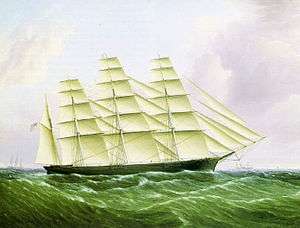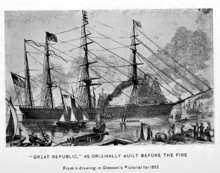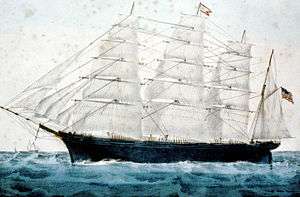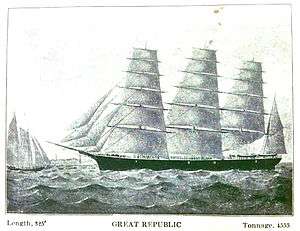Great Republic (1853 clipper)
When launched in 1853, Great Republic was the largest wooden ship in the world. She shared this title with another American-built ship, the steamship Adriatic until the launch of Great Eastern in 1860. She was also the largest full rigged ship ever built in the United States.[2]
 Clipper barque Great Republic, painting by James E. Buttersworth | |
| History | |
|---|---|
| Name: | Great Republic |
| Namesake: | Poem by Henry Wadsworth Longfellow |
| Owner: |
|
| Ordered: | 1852 |
| Builder: | Donald McKay (designer & builder) |
| Cost: | $ 450,000.00 (1853) |
| Laid down: | 1852 |
| Launched: | October 4, 1853 |
| Christened: | October 4, 1853 by Capt. A. Gifford |
| Maiden voyage: | February 24, 1855 to Liverpool, England |
| In service: | 1854 |
| Out of service: | 1872 |
| Renamed: | Denmark in 1869 |
| Reclassified: | 1862 as a three-masted full-rigged ship |
| Homeport: | Boston (1853); New York (1855); Yarmouth, Nova Scotia (1866), Liverpool (1868) |
| Identification: |
|
| Fate: | sunk in storm off Bermuda on March 5, 1872 |
| Badge: | figurehead: gilded eagle and a second gilded eagle with outstretched wings across the stern board |
| General characteristics | |
| Class and type: | |
| Tonnage: | 4,555 GRT / 4,100 NRT; after rebuild 3,357 GRT / 3,100 NRT |
| Displacement: | ~6,600 tons (5,000 tons cargo plus 1,600 tons ship's mass) |
| Length: | |
| Beam: | 53 ft (16 m) |
| Height: |
|
| Draught: | 25 ft (7.6 m) |
| Decks: | 4 continuous wooden decks, after rebuilt: 3 (with additional poop and forecastle decks) |
| Deck clearance: | 8 ft |
| Propulsion: | Sails |
| Sail plan: |
|
| Speed: | 19 kn (35.2 km/h) |
| Capacity: | 5,000 tons max. |
| Complement: | 60; originally planned: 120 |
Construction

Designed by naval architect and shipbuilder Donald McKay as a four-deck four-masted medium clipper barque, Great Republic—at 4,555 tons registry[3]—was intended to be the most profitable wooden sailing ship ever to ply the Australian gold rush and southern oceans merchant trade. The ship's launch was planned for September 4, 1853—builder Donald McKay's birthday—but it was postponed to October 4 due to problems with the timber supplies. The City of Boston made the launch a public holiday.[4] Between 30,000 and 50,000 spectators attended, among them Ferdinand Laeisz of the Flying P-Line of Hamburg. The ship was christened by Captain Alden Gifford using a bottle of pure Cochituate water. The ship's name was drawn from the title of a poem by Henry Wadsworth Longfellow. After outfitting, Great Republic sailed in ballast from Boston to New York, where in December 1853 her first cargo was loaded.

Great Republic required "1,500,000 feet of pine ... 2,056 tons of white oak, 336½ tons of iron, and 56 tons of copper" - about three times as much pine as was typically required for a large clipper ship.[5]
The Essex Institute Historical Collections provide a very detailed description of Great Republic in Volume LXIII, published in 1927.[2]
Fire and re-rigging
On December 26, 1853[6] a fire broke out in the buildings of the Novelty Baking Company on Front Street near the piers where Great Republic and several other wooden merchant vessels were moored.[7] The fire quickly spread to the packet ship Joseph Walker, and to the clippers White Squall, Whirlwind, and Red Rover, with sparks from the fire showering onto the deck of the Great Republic, whose crew was mustered shortly after midnight to unsuccessfully dowse the sails.[6] The first three ships were destroyed; Red Rover was damaged, and Great Republic burnt to near the waterline and was scuttled at dawn to save her hull at dock.[6][8][9] Bloated by grain which burst her seams,[6] Great Republic was declared a total loss, and Donald McKay, who was said never to have gotten over the tragic event, was compensated by insurers. The sunken hulk was sold by the insurance underwriters to Captain Nathaniel Palmer, working on behalf of A. A. Low and Bro., who salvaged and rebuilt it as a three-deck vessel with reduced masts.

Voyages
Still the largest clipper ship in the world at 3,357 tons registry, Great Republic, under command of Captain Joseph Lymburner, started back in merchant service on February 24, 1855. Her maiden voyage brought her to Liverpool in 13 days.
Great Republic was "chartered by the French Government to bring munitions and troops to the Crimea," and served in the general cargo and guano trades.[10] In 1862 the fourth mast was removed and the others re-rigged, and the clipper became a three-masted full-rigged ship, a so-called three-skysail-yarder. In 1864 Captain Lymburner retired and the ship's registry moved to Yarmouth, Nova Scotia. In 1869 she was sold to the Merchants' Trading Company of Liverpool and renamed Denmark. She continued sailing until March 5, 1872 when a hurricane off Bermuda caused the ship to leak badly and she was abandoned.
Records set
During her 19-year merchant career, Great Republic proved to be very fast under leading breeze conditions and often out-distanced the fastest merchant steamers on Mediterranean routes. Sailing around Cape Horn, Great Republic averaged 17 knots (31 km/h) to set a record by logging 413 nautical miles (765 km) in a single day.
Comparison to other large wooden sailing ships
A wooden sailing vessel larger than Great Republic was launched nearly three decades earlier in June 1825: the 5,294-ton Baron of Renfrew was a disposable ship built for a single voyage from Quebec to London. There it would be dismantled and sold piecemeal to English shipbuilders at premium prices since large timbers were in short supply. The vessel itself was exempt from British taxes imposed on "oak and square pine timber cargoes" and thus gained an economic advantage. Unfortunately, Baron of Renfrew was wrecked as it was being towed toward London in a storm. Although reports differ, most indicate the timbers were recovered and sold, and the venture was ultimately successful. Nevertheless, when the British tax on timber cargoes was changed shortly afterwards, the economic advantage disappeared and disposable ship construction ceased.
Great Republic was the largest, but not the longest wooden sailing ship ever built. Despite her 400 ft length overall, the record of being the longest wooden ship is held by the six-masted schooner Wyoming built at the Percy & Small shipyard, Bath, Maine, in 1909. Her overall length including her 86 ft (26 m)-long jibboom and her protruding spanker boom was 450 ft (140 m), 334 ft (102 m) on deck.
_(c112-01-42).jpg)
Further reading
- Francis B. C. Bradlee: The Ship Great Republic and Donald McKay Her Builder. The Essex Institute, Salem, MA, 1927. Reprint of the Historical Collections of the Essex Institute, Vol. LXIII.
- Octavius T. Howe & Frederick C. Matthews: American Clipper Ships 1833–1858. New York 1926, pp. 33–35
- Lubbock, Basil: The Down Easters. Brown, Son & Ferguson, Ltd., Nautical Publishers, Glasgow (1929); Reprinted 1953; pp. 49–53; p. 253
- Richard McKay: Some Famous Sailing Ships and Their Builder Donald McKay. New York 1928, pp. 210–225
- Duncan MacLean: Description of the largest ship in the world, the new clipper Great Republic, of Boston, designed, built and owned by Donald McKay and commanded by Capt. L. McKay. Illustrated with Designs of her Construction. Written by a sailor. Eastburn's Press, Boston 1853. Available online.
Notes
- Great Republic
- Essex Institute historical collections. Vol. LXIII. Essex Institute. 1927. p. 193. OCLC 6140167.
- Most likely Gross Register Tonnage or GRT measurement
- J. Ernest Kerr, Imprint of the Maritimes, 1959, Boston: Christopher Publishing, p. 135
- Crothers, William L (1997). The American-built clipper ship, 1850–1856 : characteristics, construction, and details. Camden, ME: International Marine. p. 114. ISBN 0-07-014501-6.
- Jennings, John (1952). Clipper Ship Days: The Golden Age of American Sailing Ships. New York: Random House. p. 162., accessed May 30, 2018.
- "GREAT CONFLAGRATION!; SEVERAL BUILDINGS AND SHIPS ON FIRE. Ship Great Republic in Flames. Over $1,000,000 worth of Property Destroyed". The New York Times. New York. December 27, 1853. p. 1. Retrieved March 15, 2010.
- "The Great Conflagration. Three Clipper-Ships Destroyed. Total Loss of the Great Republic. Burning of the White Squall, and Joseph Walker. Nine Buidings [sic] Destroyed on Front-St. Loss, $1,500,000. Insurance, $500,000 to $700,000. Additional Fire--Incendiarism, & c." The New York Times. New York. December 28, 1853. p. 1. Retrieved March 15, 2010.
- The American Almanac and Repository of Useful Knowledge, for the year 1855. 1855. pp. 345–. Retrieved 31 March 2013.
- "SEA AND SHIP NEWS.; Voyage of the Clipper-ship Great Republic. THE FALKLAND ISLANDS--PORT STANLEY AND OTHER HARBORS-THE PEOPLE, SOIL AND CLIMATE--TRADE OF THE ISLANDS--THE PATAGONIAN MISSION". The New York Times. New York. July 6, 1858. p. 3. Retrieved March 15, 2010.
References
- Great Republic on Nautica , checked 2009-01-29
- Clipper ship history by Lars Bruzelius , checked 2007-08-22
External links
| Wikimedia Commons has media related to Great Republic. |
- Figurehead from clipper ship Great Republic, Mystic Seaport
- Model of Great Republic
- "Description Of The Largest Ship In The World, The New Clipper, Great Republic, of Boston. Designed, built, and owned by Donald McKay. (From The Novascotian)". The Newfoundland Express. St. John's, Newfoundland. January 7, 1854. p. 3. Retrieved March 15, 2010.
- Winchester, Clarence, ed. (1937), "The biggest sailing ship of her time", Shipping Wonders of the World, pp. 491–494 illustrated description of Great Republic
- Pacific Marine Review (1921). "Our Greatest Wooden Ship". Pacific Marine Review. 'Official Organ: Pacific American Steamship Association/Shipowners' Association of the Pacific Coast. Consolidated 1921 issues (December): 706. Retrieved 24 September 2014.
- Matthews, F. C. (1921). "The Clipper Ship Great Republic". Pacific Marine Review. 'Official Organ: Pacific American Steamship Association/Shipowners' Association of the Pacific Coast. Consolidated 1921 issues (December): 707–710. Retrieved 24 September 2014.